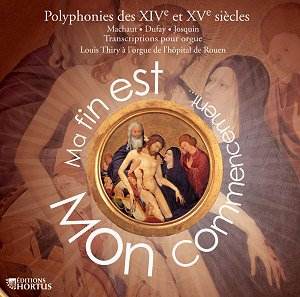
Buy
through MusicWeb for
£14.99 postage paid
World-wide.
Immediate delivery direct
from Editions Hortus
You may prefer to pay by Sterling cheque to
avoid PayPal or CCNow charges. Contact![]() for details
for details
![]()
Ma fin est mon commencement...- Rondeau 14 [1'40]
Moulte sui de bonne heure nee -Virelai 37 [2'25]
Dame, mon cuer m'emportes -Virelai 32 [1'38]
Sanz couer m'en vois -Ballade 17 [1'45]
Ha! Fortune -Motet 8 [1'34]
Guillaume DUFAY (c1400-1474)
Se la face ay pale [1'52]
Ce jour l'an voudray joye mener [1'43]
Bon jour, bon mois, bon an et bonne estraine [1'39]
Par droit je puis bien complaindre et gemir [2'00]
Craindre vous vueil, doulce dame de pris [1'24]
Adieu ces bons vins de Lannoys [3'05]
J'attendray tant qu'il vous playra [1'32]
Adieu m'amour, adieu ma joye [4'07]
Malheureulx couer, que vieulx tu faire? [3'49]
Alma redemptoris Mater [2'58]
Vergena bella, che di sol vestita [3'26]
Josquin DES PRES (c1450-1521)
De profundis clavami [6'30]
Gloria (Missa Pange Lingua) [4'18]
Sanctus (Missa Hercules dux Ferrarie) [5'22]
Rec. Chapelle de l'hopital Charles-Nicolle de Rouen, May-June 2004 DDD






